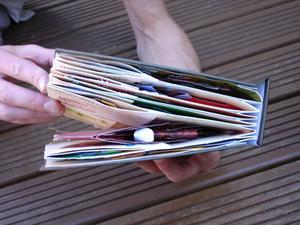Have you ever had one of those really complicated pop-up books where the dinosaur leaps out of the page towards you in 3-dimensions with every tooth and scale separately attached in perfect and horrifying detail? I have, and if you're like me then you've probably also taken a peek behind the dinosaur to find out how the pop-up works. Peering between the pages like this is similar to the work that goes on in labs around the world where scientists are trying to understand the workings of one of Nature's most powerful polymers - the protein.
Proteins are massive molecules that are crucial for keeping the cells in our bodies in working order. For instance they provide the rails and the motor for microscopic cellular 'trains' that move biochemical cargos from one end of a cell to another, they act as molecular messengers allowing cells to communicate with each other and they package DNA so that the regions of the genome that aren't being used are tidily coiled away. They also monitor what the cell is doing, and when something causes trouble, they get rid of it, which might even involve killing the cell. And just as the pop-up book is made from pieces of card glued to the page in the right order, proteins are made from molecular cards called amino acids, which are linked together in the right order.
If this gluing is done correctly, the protein spontaneously folds to take up its completed 3D shape. And just like opening a pop-up book, most of the time the protein folding works smoothly, but occasionally things can go wrong. A mutation in the DNA sequence coding for a certain protein can lead to the inclusion of the wrong amino acid, which is akin to inserting a wrongly shaped piece of card in the pop-up book. This causes the mature protein to go out of shape or "mis-fold", so it cannot carry out its intended role correctly.  In fact an amazing 80% of human disease-causing mutations affect proteins in this way.
In fact an amazing 80% of human disease-causing mutations affect proteins in this way.
Proteins recognise and interact with each other according to their shape, so having the correct structure is critical for a protein to work effectively. If it fails in this role the results can be fatal. For instance some proteins do the job of killing malfunctioning cells, such as cells that have become malignant, and under these circumstances a failure in the process can mean cancer.
But while many people have been working on ways to treat diseases by correcting the function of affected proteins, my research looks at the fundamental question of how proteins fold when they are working properly. If we want to understand complicated diseases, we first need to understand how things work normally. A lot of the questions I'm asking are just the same as those you might ask about the pop-up book. What does the folded protein look like? What does the unfolded one look like? Is there a preferred order or logic to the self-assembly?
The proteins I study are 100 million times smaller than the pop-ups in a book, and a hundred times smaller than even a light microscope can see. The result is that I can't just watch what happens - instead I have to infer it by measuring other things. For example, by measuring the speed at which a protein folds and then substituting one amino acid building block for another before repeating the measurement, I can find out which parts fold first. Then, by comparing the results for similar proteins, it's possible to work out how small differences in amino acid sequence affect the way the protein folds.
At the moment, if we design a new protein we can only guess what the final shape will be - but it is the final shape that dictates what the protein can or cannot do! Making new proteins is a bit like knowing what you want the pop-up to look like, but clumsily sticking pieces of card onto the book without really understanding how the process works.
But there are ways around this: if you take a protein similar to the product you want, you can make small changes and slowly build up something useful. It's a bit like changing the pop-up dinosaur into a dragon, although making it into a Volkswagen Beetle would be much harder. My hope is that one day we will fully understand the rules of our pop-up books - not only to understand disease but also to treat it by designing protein drugs that will do exactly what we choose.
- Previous Vile-din? Certainly Not!
- Next How To Be A Wildlife Photographer










Comments
Add a comment